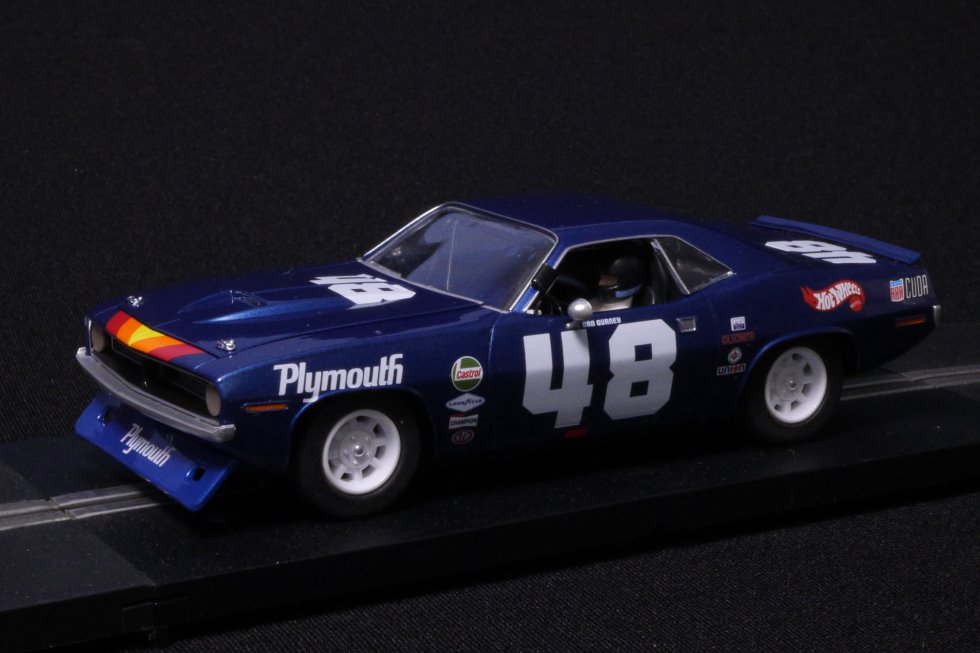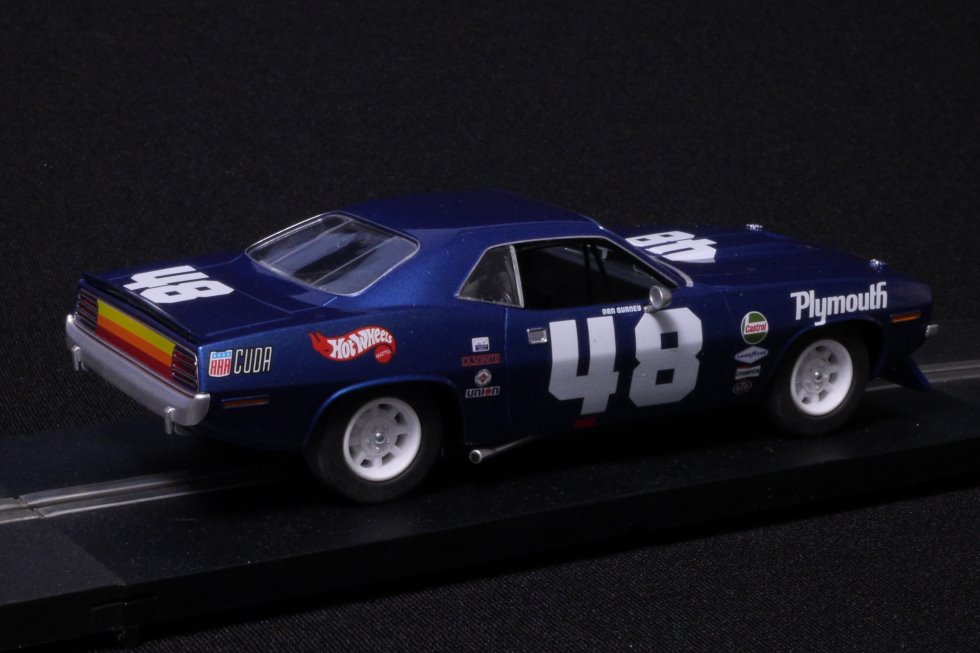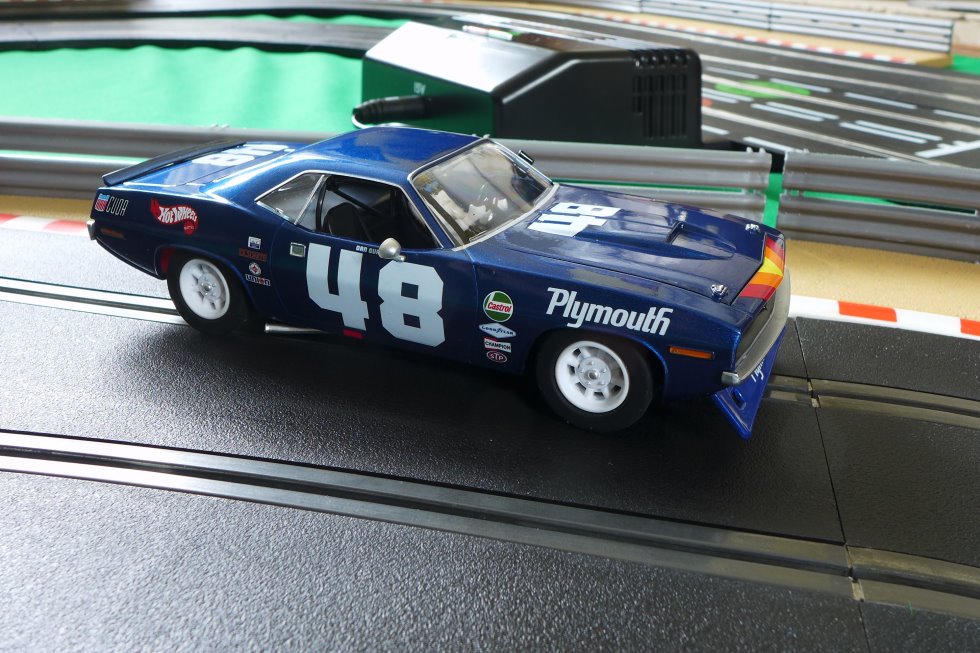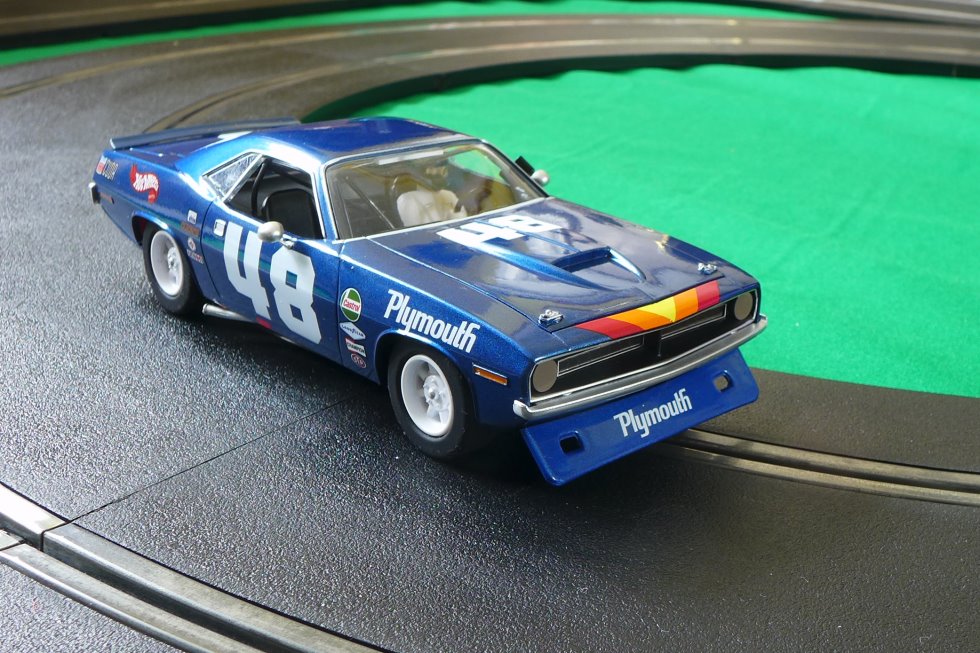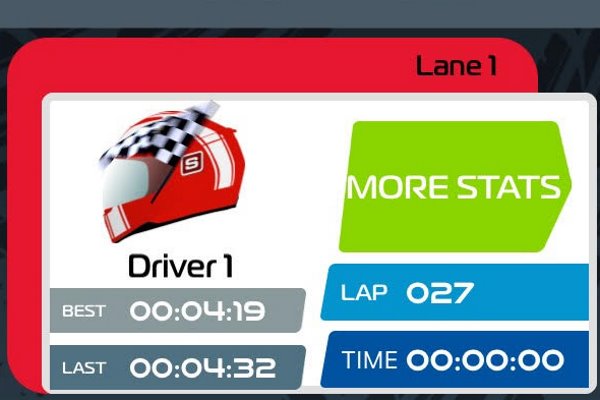The Scalextric catalogue has plenty of treats for fans of American muscle cars this year…
Brand new for 2021, the Plymouth Barracuda is an icon of Trans-Am racing. And it’s no surprise the first livery is of the All American Racers team, driven by legend Dan Gurney. Scalextric kindly loaned me a pre-production sample of this awesome car to have a close look at and to test drive.
The Scalextric model is part of the classic Trans-Am range and is fitted with a sidewinder motor and a full interior to match the earlier Camaros, Boss Mustangs and Dodge Challengers. Its sister car – the Chrysler Hemicuda – raced in European saloon car events, so there are some very nice liveries for Scalextric to reproduce.
The Dan Gurney Barracuda is due to arrive this month and can be pre-ordered here: www.jadlamracingmodels.com/scalextric-slot-car-c4219-plymouth-barracuda-trans-am-1970-dan-gurney/. The Chrysler France Hemicuda will be available during the winter: www.jadlamracingmodels.com/scalextric-slot-car-c4247-chrysler-hemicuda-spa-24-hours-1973-bertinchamps-deprez/
The Real Plymouth Barracuda
The original Barracuda was launched in 1964 as a sporty upgrade of the Plymouth Valiant – aimed to rival Ford’s new Mustang. In the battle of the ‘pony cars’, the ‘Cuda was no match for the ground-breaking Ford. However, when a new version was released in 1967, the Plymouth gained a strong following amongst drag racers – and Hurst Performance prepared fifty lightweight 7-litre cars for Super Stock competition.
The third generation Barracuda was launched in 1970 – alongside a factory-backed entry into the prestigious Trans-Am championship. Dan Gurney’s All American Racers were given responsibility – and a rumoured $1.5 to $2 million budget – to build the Plymouth Barracudas and Dodge Challengers on behalf of the Chrysler corporation. Drag racing maestro Keith Black was hired to develop the 5-litre engines. AAR would run the Barracudas for Gurney and Swede Savage and Autodynamics developed the Challenger for Sam Posey to drive.
Sadly, the season didn’t turn out as hoped for AAR’s Barracudas. Despite some pole positions, there were no wins – and Chrysler pulled back on their funding, leaving only one car for the second half of the season. Gurney handed the driving gloves to the up-and-coming Savage, who was brave and fast. Savage wrecked his car at St Jovite, but continued in Gurney’s. Gurney was back for the final two races, funding this third car himself. The two Barracudas finished fourth and fifth at the final race at Riverside, but there was no reprieve – Chrysler axed their Trans-Am programme.
Looking back, the AAR Barracudas were probably only a few parts away from race wins and a serious shot at the championship. The 1970 season was the competitive high-point of Trans-Am – all the works teams, apart from AMC, withdrew at the end of the year. In the history books, the Barracudas stand out as the best looking cars of that iconic Trans-Am season. Restored AAR ‘Cudas – and replicas – take pride of place at historic Trans-Am events and in collections and museums across North America. It’s brilliant the car is available again to slot car collectors and racers.
The Scalextric Model
Although missing a couple of smaller decals, the Scalextric model looks very close to the car Gurney drove at Riverside – his final professional race and the end of the Barracuda’s Trans-Am career. It’s also almost identical to the historic racer owned and driven by Craig Jackson. This is the ‘third’ car and the red, orange and yellow stripes were only present on the front lip – not continuing over the bonnet as on the two other Trans-Am ‘Cudas.
The shade of metallic blue looks right to me. I’ve gone to my Trans-Am books as a reference (often more reliable for colours than web-based digital images) and the period photographs match the blue on the Scalextric model. Some of the better restorations also have that blue – although there are photos on the internet, diecast models and replicas that range from royal blue to black. It’s a great finish that really comes to life in different lighting conditions.
The sidewinder layout of the Scalextric model allows a detailed deep interior, which is shown off very well through the open side windows. The big front spoiler adds to the muscular look of the car – and modellers could add hoses through the two openings to give an extra-detailed look. Bonnet clips are present and there’s a slightly strange clip on the driver-side A-pillar, which is absolutely authentic! Wing mirrors are flexible, but weren’t often fitted to a Trans-Am racer. Windscreen wipers were, but the Scalextric model only has a hint of them – unpainted ridges on the windscreen. This is a similar arrangement to the Camaro Z28, but not as effective. Underneath, the rather fragile-looking exhaust pipe is flexible and should withstand some punishment.
Finally, the wheels are an authentic replica of the 1970 AAR hubs and suit the model perfectly. They are the new standard size, allowing NSR and Slot.it tyres to be fitted, if you so wish. That will be of particular interest to club racers running the cars without magnets.
The Mechanical Stuff
Underneath, we can see clearly that the Barracuda has a sidewinder layout. The underpan is Digital Plug Ready (DPR), meaning it can be easily converted to Scalextric digital using the C8515 Digital Plug or to Carrera Digital132 using the Carson digital conversion chip. There’s also the standard easy-change guide, plus a magnet right under the rear axle. This registered a pretty decent 41g of downforce on my DIY magnet gauge.
Removing the body was not at all easy. The rear screw comes out okay – but the front two are retained in the spoiler, which is a separate part. Even when these are fully loosened, firm handling is required to separate the body from the underpan. Everything is very tight – giving a great-looking body, but a pain to remove and limits any movement. Club racers will have their work cut out to decouple body and underpan for that all-important body float.
Once inside, there’s the typical sidewinder layout. There are lugs present to fit light boards, but these are not included – Trans-Am cars ran without headlights, although rear brake lights could have been fitted to this model. Presumably the Chrysler Hemicuda will have both front and rear lights.
The slick rear tyres are a chunky 9mm wide and feeling quite grippy. At 54.5mm – the rear track is a couple of millimetres less than the 1970 Camaro. At the front, the tyres just touch the track surface – perfect for handling and definitely an improvement over the other Trans-Am models.
The full interior does add extra weight to the car and to the body. Overall, the ‘Cuda weighs in at 86g – 35g of that is in the body and front spoiler.
Track Performance
After some of the recent Scalextric offerings, I was expecting something equally special from the Barracuda. I eagerly set up the Jadlam SL6 test track and got ready for some fun. To begin with, I have to say I was a little disappointed. Although the car was quick and handled well, it had a tendency to tip – the car didn’t slide, it ended up on its roof. That meant I needed to be smooth and precise, rather than push it hard. Normally, I would loosen the screws to give some body float, but that wasn’t possible with the tight fit of the ‘Cuda.
Dialling back my driving style a bit, I got into a good rhythm and fired up the ARC app for a timed two-minute run. I managed a good, clean 27 lap stint, plus a best lap time of 4:19 seconds – really rather good. Although a lap behind the new Camaro Z28, the ‘Cuda sits comfortably in the top half of the new Scalextric cars I’ve tested over the past 12 months.
I desperately wanted to experiment with a non-mag session – these Trans-Am cars are popular with club racers – but the magnet was very firmly installed… so I will have to wait to get my own. If a bit of body float can be achieved, I think the Barracuda will be a fun and effective non-mag car to drive. It will need some work, but I expect to see the ‘Cuda fighting for wins in Trans-Am slot car races around the world.
In conclusion, the AAR-liveried Plymouth Barracuda is a beautiful looking model of an important classic racer. It is a perfect addition to any Trans-Am collection. On track, it should certainly hold its own – with or without the magnet – but it will need a little work to get it handling exactly to your tastes.
A very big thank you to the Scalextric team for providing yet another 2021 car to preview. It is definitely proving to be a vintage year! I hope you’re enjoying these previews – there will hopefully be a couple more between now and Christmas.
Scalextric Plymouth Barracuda – Trans Am 1970 – “Dan Gurney” Data Sheet
Catalogue code: C4219
Available here: https://www.jadlamracingmodels.com/scalextric-slot-car-c4219-plymouth-barracuda-trans-am-1970-dan-gurney/
Range: Scalextric Classic GT Cars – 1/32 scale / high detail / Digital Plug Ready (DPR)
Scheduled: September 2021
Spares included: 2 x braid plates with braid fitted
Lights: None
Motor: Scalextric ‘short-can’ – sidewinder orientation.
Gear ratio: 11:36
Length: 148mm
Wheelbase: 85mm
Rear axle width: 54.5mm
Height: 39mm
Weight: 86g (body = 35g including front spoiler)
Andy’s downforce gauge: 43.5g magnetic downforce




